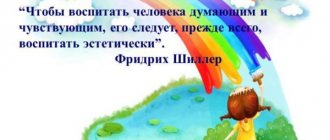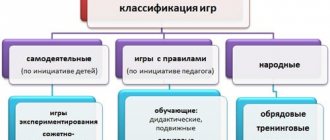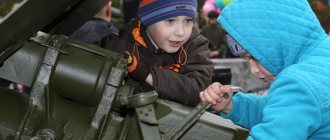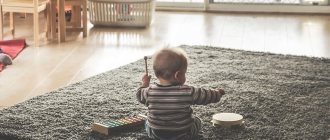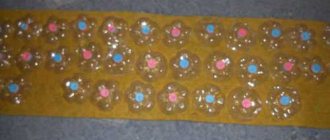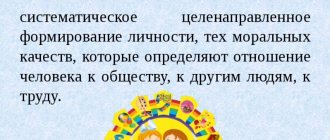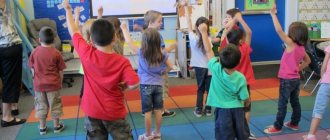In modern pedagogy and education of children, the aesthetic education of preschool children is of particular importance, designed to create all the prerequisites for the formation of a developed and harmonious personality. Without it, the child will not be able to appreciate beauty, receive true pleasure while listening to classical music or contemplating a painting, and even more so will not be able to create something of his own. He will become spiritually poor, boring, and will not be able to understand his emotions, because when he touches something beautiful, something inside him will respond, but he will not be able to understand what exactly. That is why parents should include this important aspect in their parenting tactics, without shifting all responsibility to preschool employees - the role of the family in the formation of personality is very great. For children of different ages, a variety of methods can be used and a variety of means can be used.
What it is?
The word “aesthetics” is of ancient Greek origin and means “sensory perception.” And aesthetic education is the development in a child of the ability to perceive, understand, and analyze beauty both in art and in everyday life, as well as the desire to create his own works.
Note that the words “beautiful” and “beautiful” are not synonymous, since the second concerns primarily form, external expression, while beauty can be found even in the most ordinary things, it includes harmony, spirituality, sublimity.
The desire to notice the beauty of the world around us and a love for works of art should be constantly and purposefully cultivated in a child from the first months of his life. It is important not to focus on the development of artistic and musical perception, but to set as a goal the formation of a harmonious personality.
In addition to its direct purpose, aesthetic education of children allows them to develop:
- thinking;
- imagination;
- memory;
- system of interests;
- perception;
- moral qualities;
- active attitude towards life.
And, of course, the child learns to understand art and strive to create his own works.
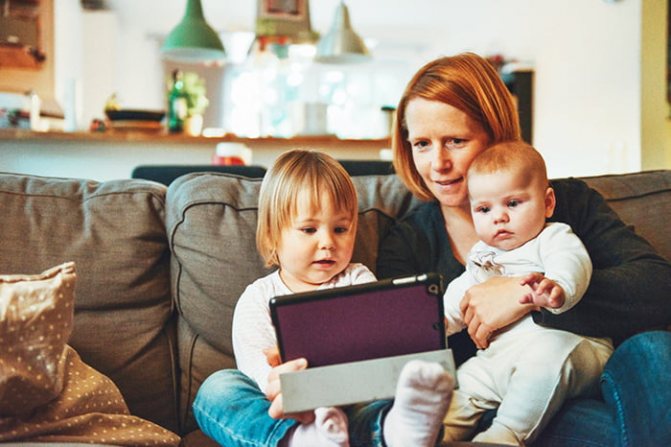
At home
From early childhood, children have a certain craving for beauty; they are attracted to brightly decorated toys, shiny and colorful objects. Kids get real pleasure listening to music or rhymes or fairy tales that their mother reads to them. These impulses, while unconscious, gradually become conscious, but only if the parents help the baby develop harmonious taste, creative and artistic abilities, and aesthetic ideas. This is the only way to ensure that the child’s personality is developed and he himself is happy.
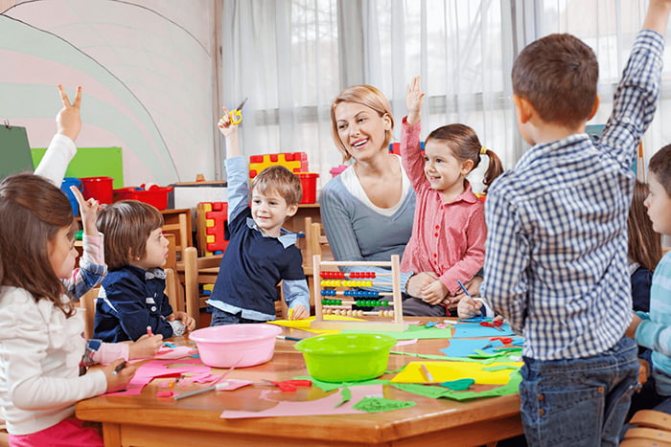
In kindergarten
In preschool educational institutions, the work of cultivating the desire for beauty is also of enormous importance. For this, the necessary conditions must be created, certain forms of activities must be carried out - creating crafts, drawing, modeling, listening to classical works of art accessible to children and talking about what they have listened to. Therefore, aesthetic education of preschoolers is a task simultaneously facing parents and educators.
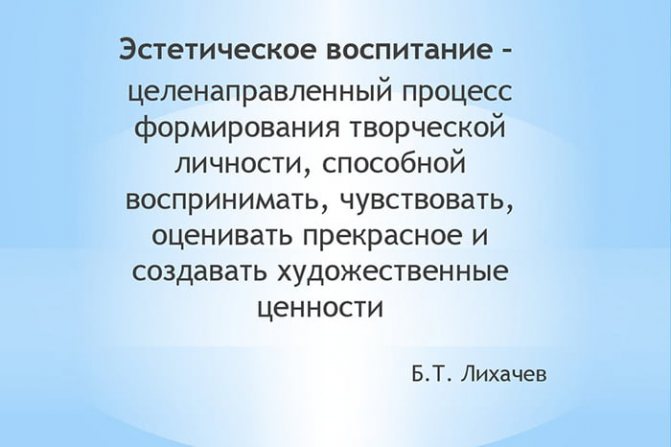
Artistic and aesthetic development and artistic and aesthetic education of preschool children
Ekaterina Chernysheva
Artistic and aesthetic development and artistic and aesthetic education of preschool children
«Artistic and aesthetic development»
and “
Artistic and aesthetic education .
Before talking about the concept of “ artistic and aesthetic development ”
Let us consider the concepts of
“aesthetic
education ” and
“
artistic education ” .
Aesthetic education of preschoolers is a long process, the goal of which is to develop in children the ability to perceive the beauty of the world around them, as well as the development of creative abilities that are in their infancy. It starts almost from birth. Aesthetic education of young children , essentially preschool , is a fairly broad concept. It includes the development of attitudes towards the world , everyday life, nature, work and social life in general.
Artistic education is identified as its component .
Artistic education involves education through the means of art. According to classical studies, its main goal is the formation of a culture of creative personality, which manifests itself socially and individually and which, in the process of identifying the internal image and in the creative perception of the external world, creates artistic values . Its main task is to form a child’s positive and active attitude towards art and the need for it.
The concept of "aesthetic education "
much broader, it affects both
artistic creativity and the aesthetics of everyday life, behavior, work, and relationships. Aesthetic education shapes a person with all aesthetically significant objects and phenomena, including art as its most powerful means. Aesthetic education artistic education for its purposes , develops a person mainly not for art, but for his active aesthetic life.
There are different definitions of the concept of “ artistic and aesthetic education ”. Let's look at some of them.
From the dictionary of aesthetics: artistic and aesthetic education is a system of activities aimed at developing and improving a person’s ability to perceive , correctly understand, appreciate and create the beautiful and sublime in art.
N. Varkki gives the following formulation: artistic and aesthetic education of preschool children is “a purposeful process of forming a creatively active personality of a child, capable of perceiving and appreciating the beauty in life and art.”
Zaporozhets I.D. defines artistic and aesthetic education as “the organization of children’s life and activities, promoting the development of the child’s aesthetic and artistic feelings , the formation of ideas and knowledge about the beauty in life and art, aesthetic assessments and an aesthetic attitude towards everything that surrounds us.”
In both definitions, we are talking about the fact that artistic and aesthetic education should form artistic taste , develop and improve in the child the ability of aesthetic awareness of beauty in art and in life, to correctly understand and evaluate it.
According to D. B. Likhachev, artistic and aesthetic education is a purposeful process of formation of a creative personality capable of perceiving , feeling, appreciating beauty and creating artistic values .
T. N. Fokina believes: “ Artistic and aesthetic education is the education of a holistic, harmoniously developed personality , which is characterized by a well-formed aesthetic consciousness, the presence of a system of aesthetic needs and interests, creative abilities, a correct understanding of beauty in reality and art.”
From these definitions it is clear that artistic and aesthetic education develops the ability for independent creativity and the creation of beauty, develops the ability to creatively create handmade products.
So, artistic and aesthetic education has an active and creative orientation, which should not be limited only to a contemplative task, it should also form the ability to create beauty in art and life.
These goals are also reflected by the peculiarity of artistic and aesthetic education as part of the entire pedagogical process. Any goal cannot be considered without tasks. Most teachers (G. S. Labkovskaya, D. B. Likhachev, E. M. Toroshilova and others)
There are three leading tasks
of artistic and aesthetic education :
- the creation of a certain stock of elementary aesthetic knowledge and impressions, without which inclination, craving, and interest in aesthetically significant objects and phenomena cannot arise.
— “the formation, on the basis of acquired knowledge, and the development of the abilities of artistic and aesthetic perception of such socio-psychological qualities of a person that provide her with the opportunity to emotionally experience and evaluate aesthetically significant objects and phenomena, to enjoy them” (V. G. Razhnikov)
.
artistic and aesthetic creative ability in each The essence of this task is that the child must not only know beauty, be able to admire and appreciate it, but he must also actively participate in the creation of beauty in art and life, and independently create handmade products. The result of artistic and aesthetic education is artistic and aesthetic development as “the process and result of mastering the aesthetic and artistic experience of mankind , the development of the ability to experience various phenomena of reality as beautiful, to respond emotionally to artistic images and the manifestation of beauty in the world; formation and improvement of aesthetic consciousness, attitude to human aesthetic activity" (A. G. Gogoberidze, O. V. Solntseva)
.
It is important to develop such qualities , such abilities that will allow the individual not only to achieve success in any activity, but also to be the creator of aesthetic values, to enjoy them and the beauty of the surrounding reality. In addition to the formation of artistic and aesthetic attitude to reality and art, artistic and aesthetic education simultaneously contributes to their comprehensive development . It contributes to the formation of a person’s morality, expands his knowledge about the world, society and nature. A variety of creative activities for children contribute to the development of their thinking and imagination, will, perseverance, organization, and discipline.
The entire system of artistic and aesthetic education is aimed at the overall development of the child, both in aesthetic and artistic terms , and in spiritual, moral and intellectual terms. This is achieved by solving the following tasks: mastering the child’s knowledge of artistic and aesthetic culture , developing the ability for artistic and aesthetic creativity and development of aesthetic psychological qualities of a person, which are expressed by aesthetic perception , feeling, evaluation, taste and other mental categories of aesthetic education .
The concept of “ artistic and aesthetic development ”
is broader than the concept of
“
artistic and aesthetic education ” , since in
the artistic and aesthetic development of the individual the main role is given to artistic and aesthetic education - as a purposeful, systematic activity to manage the process of formation of the personality as a whole or its individual qualities. But, as we know, development also depends on interaction with the environment and on biological factors. While artistic and aesthetic education depends on the spiritual and moral values that are accepted in the family, society, and state, that is, it depends on the environment in which a person is brought up .
How (with what)
artistic and aesthetic development carried out educational organization?
In accordance with the Federal State for preschool education, artistic and aesthetic development assumes :
— development of prerequisites for value-semantic perception and understanding of works of art (verbal, musical, visual, the natural world;
- the formation of an aesthetic attitude towards the surrounding world;
— formation of elementary ideas about types of art;
- perception of music , fiction , folklore;
- stimulating empathy for the characters of works of art ;
- implementation of independent creative activities of children (visual, constructive-model, musical, etc.)
.
Artistic and aesthetic development by communication with beauty in all its manifestations. First of all, it should be highlighted:
— communication with beauty in nature;
- communication with art (music, literature, theater, works of artistic and decorative creativity );
- communication with beauty in everyday life, including human relationships.
Aesthetic communication is a special condition and means of aesthetic education , aimed at getting children interested, igniting their hearts, developing activity in them , awakening in every child faith in his creative abilities, in the fact that he came into the world to create goodness and beauty, bring people joy.
Educational work on the artistic and aesthetic development of children in preschool educational institutions should be carried out simultaneously in several directions:
— interaction between teachers and children.
- interaction with families.
— cooperation with institutions of the social and pedagogical environment.
One of the most important components of the system of work on the artistic and aesthetic development of children is the organization of the educational process. In kindergarten, interaction between teachers and children on artistic and aesthetic development is carried out through the following forms of work:
- direct educational activities (classes in basic activities: drawing, modeling, appliqué, music, reading fiction ). Modern forms of organizing classes are diverse and are designed based on an understanding of the essence and originality of artistic , musical, and verbal works of art. It is also necessary to organize work with an artistic and aesthetic orientation in all types of classes (integration of educational areas)
.
This is the inclusion of artistic expression , musical accompaniment, demonstration of illustrations, dramatization, etc. Educational situations can be organized during a walk (drawing “in the open air”
, etc.)
- joint activities of teachers and children (holidays, entertainment , themed musical evenings, theatrical performances, didactic games, exhibitions of drawings and crafts, etc.). The modern form is projects of an artistic and aesthetic orientation . You can take as a basis the topics proposed by the children, as well as those provided for in the educational program. One of the interesting forms of organizing children's activities is an excursion (to parks, gardens, museums, theaters, around the city, to the library, etc.)
.
At the same time, we must remember that the main object of cognition should remain the emotional and figurative contemplation of what is perceived (genuine objects in their pristine state, harmony and connection with the surrounding space).
- independent children's activities (games and exercises that stimulate the expansion of aesthetic experience, its processing and reflection; design activities aimed at changing the group space and “play corners”
, compiling various collections, staging, productive activities, activities based on interests, etc.).
Work with children on artistic and aesthetic development is carried out in the following areas:
-introduction to the fine arts and the development of creativity in visual activity (activation and development of an emotional response to the manifestation of beauty in the surrounding world, its depiction in works of art and one’s own creative works, the development of artistic and aesthetic perception , aesthetic assessments, preferences, desire to experience art; development emotional-aesthetic, creative, sensory and cognitive abilities, development of visual activity, activation of creative manifestations of children in the process of familiarization with art and their own visual activity).
-musical education ( development of general musical culture, accumulation of experience in interaction with musical works, development in the child of the position of an active participant, performer-creator of musical works, in order to express himself, his emotions, feelings, moods, experiences in singing, dancing, playing music).
-literary development (as a process of qualitative changes in perception , interpretation of literary texts and the ability to reflect literary experience in different types of artistic activity ).
It is important to remember that in artistic activity (both organized and independent)
There must be both
a reproducing (reproductive)
factor and a creative one.
Both of them are necessary and interconnected, because a child will not learn to create without learning to reproduce .
The content of the artistic and aesthetic development of children is presented in the sections of comprehensive programs, partial programs and technologies. Modern programs are focused on the ideas of an integrative approach: combining different types of arts (music, speech, theater, fine arts)
into
an artistic whole .
However, no educational influence of an adult can be successfully implemented without the real activity of the child himself. At the same time, it is important to remember that activity in an enriched subject-development environment , which should initiate the child’s activity and direct him to creativity.
Goal, objectives
The goal of this direction in education is the formation of an aesthetic culture in a person, which consists of the following aspects:
- Perception. This is the ability to notice various forms of manifestation of beauty, including in nature, work, and everyday life.
- Feelings. The ability to emotionally evaluate harmony and perfection.
- Needs. The desire to receive aesthetic pleasure, to contemplate works of art, the beauty of nature.
- Tastes. Ability to conduct assessments. Analysis of real world objects from an aesthetic position.
- Ideals. Individual ideas about what is perfect and harmonious in nature, people, and art.
The goal of aesthetic education is specified in a number of tasks:
- Developing in a child the ability to see beauty and appreciate it.
- Formation of a harmonious personality.
- Development of artistic taste.
- Formation of an aesthetic ideal, the desire to become beautiful not only externally, but also internally, in actions, thoughts, and deeds.
- Stimulating creative abilities and the desire for their development.
As a result of upbringing, a child must understand what harmony and perfection are, be able to empathize, be distinguished by emotional responsiveness, and imagination.
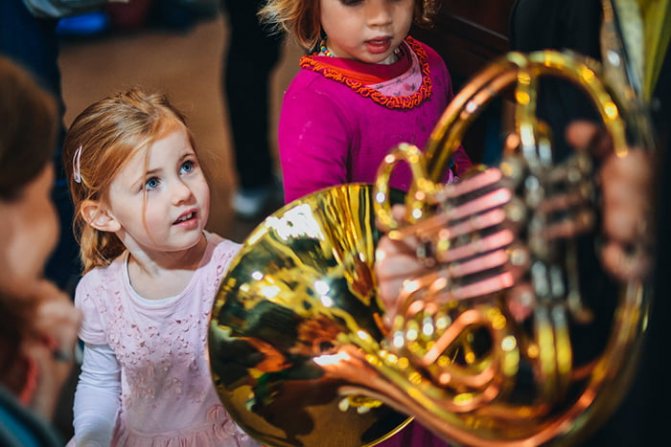
Facilities
Let's consider the means that parents can use to introduce their baby to the world of beauty. There are quite a lot of them:
- fine arts (sculpture, painting);
- dramaturgy;
- architecture;
- literature;
- music;
- TV;
- nature;
- MASS MEDIA.
Since teaching a child to notice and appreciate beauty is very difficult, you should use all available means.
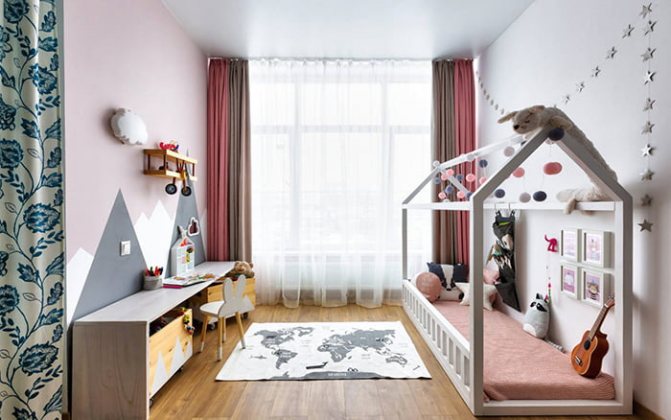
Room decoration
For the little ones it is important to create a harmonious environment in the room:
- Create harmony and comfort in your baby's room.
- It is preferable to use light colors in the design.
- The space should not only be ergonomic, but thoughtful.
The room should be beautifully arranged with toys, interesting reproductions should be hung, and it should be kept clean and tidy. Flowering plants placed in a harmonious composition and a decorated aquarium with fish will also help you achieve your goal. All decorative elements must be combined with each other, forming a single ensemble.
For children of primary preschool age, you can choose a painting depicting an animal, a familiar fairy-tale character, or a “delicious” still life. Older children will like the landscape, so it is better to use reproductions of Savrasov, Serov, Shishkin, Levitan. To prevent the child from losing interest, the paintings should be changed periodically, while telling the child information about the work itself and its author.
In addition, the children's room can be decorated with folk crafts, Dymkovo toys, and Khokhloma crafts. Of course, you shouldn’t place expensive collectibles on the table of a young prankster, but something inexpensive made of ceramics can become a worthy decoration.
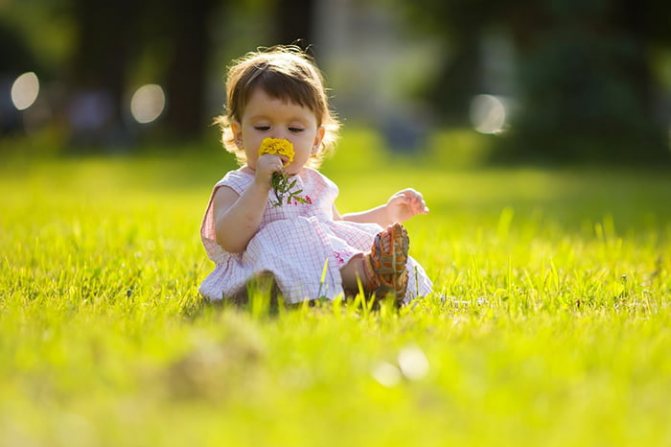
Nature
From an early age, parents need to instill in their child that trees and flowers, sunset and sunrise, clouds in the sky and waves in the river are beautiful, they need to be taught to enjoy this beauty. To do this, you should introduce children to works about nature that are accessible to them, spend time in the fresh air, talk, answer questions, and set your own example.
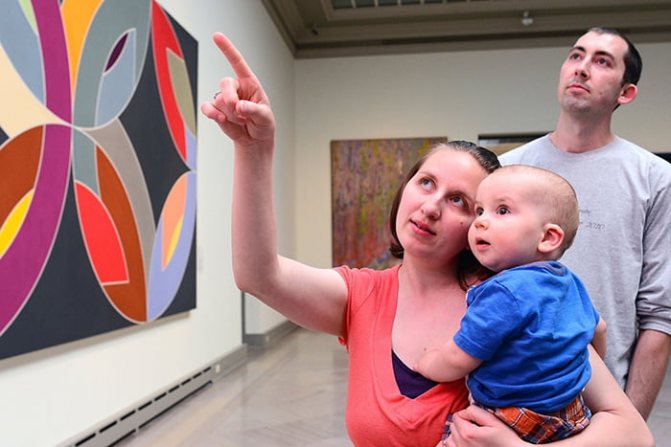
Art
A lot can be used to educate children aesthetically. So, in any city there are beautiful streets, architectural buildings, museums, and exhibitions are held. Preschoolers enjoy learning something new by visiting such places. Walking around the city, you can introduce your child to the main attractions, paying attention to their sophistication and harmony.
If there are no museums in the city, reproductions and virtual excursions, which can be viewed via the Internet, will help introduce your child to works of art. It is necessary to include outstanding musical works for the little ones, talk about what they listened to, find out what thoughts and emotions were evoked by the music of Beethoven or Mozart, Tchaikovsky and Rachmaninov.
And, of course, we should not forget about literary works. Preschoolers can understand Pushkin's fairy tales, especially if they look at high-quality color illustrations. You should also introduce them to the poems of Marshak, Barto, and the stories of Prishvin and Zhidkov.
It is important for parents to remember that not every child will become an artist or musician, but everyone should be able to feel the beautiful and receive special pleasure from it. Therefore, you should not just ask your child to draw something or make a craft or appliqué, but also pay attention to already created objects of spiritual value.
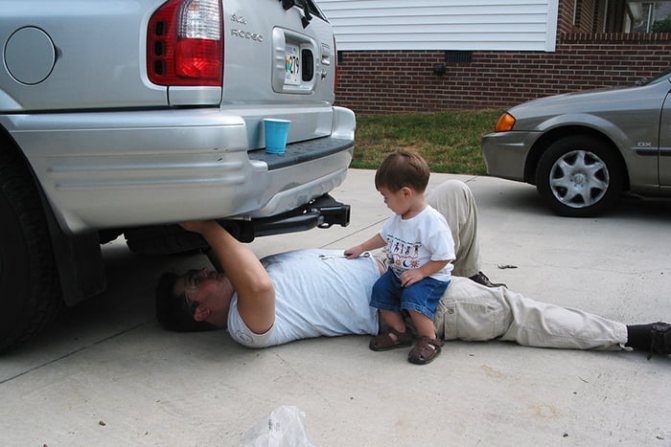
Work
When carrying out the tasks of aesthetic education of children, you should introduce them to the benefits of work, tell them that there are a large number of professions, each of which is important.
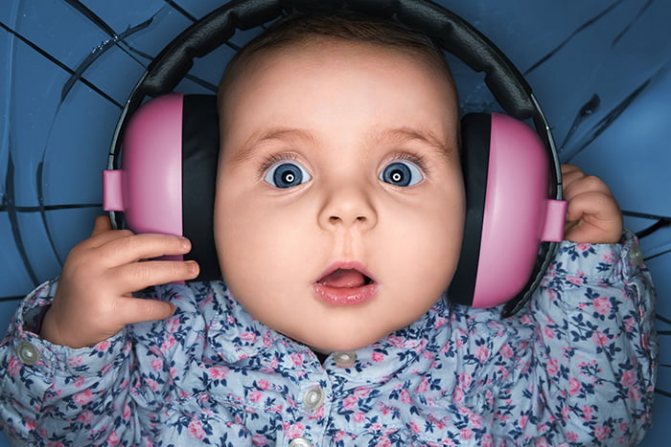
Artistic development of preschool children in preschool educational institutions
Artistic and aesthetic education plays a special role in the life of a preschooler.
Important ! It is worthwhile to instill in a child a sense of beauty from early childhood and teach him to understand works of art.
Artistic education of children through the use of fine arts
The younger age of children makes them more receptive to the visual arts, which has a direct impact on artistic education. Artistic development is the ability to evaluate works of art, understand them, experience emotions from contact with them and create independently.
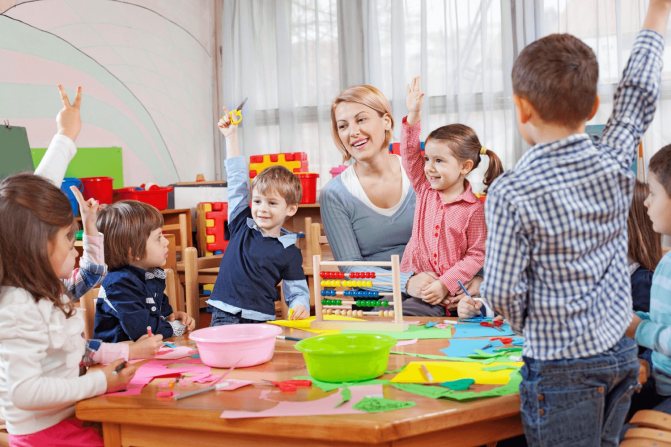
Kids need to be developed
It is important for preschoolers (preferably from the age of 1) to familiarize themselves with all types of fine arts as self-education:
- Sculpture is a work performed in volume in various ways.
- Painting is an image made with paints on a plane.
- Architecture - the creation of buildings and structures.
- Graphics is an image on a plane without color, using lines, strokes, and dots.
- Decorative arts are the decoration of something.
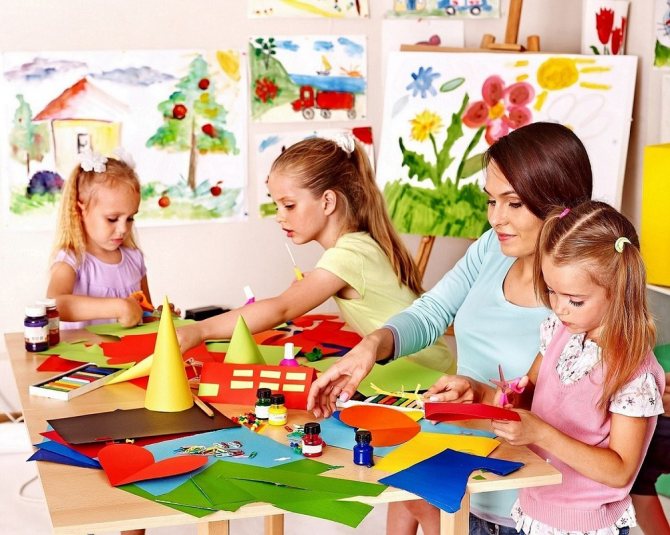
Children love paintings
It is also important to familiarize yourself with the various materials, of which there are different types:
- pencils;
- gel pens;
- ink and pen;
- gouache paints;
- watercolor;
- oil;
- acrylic;
- oil and dry pastels;
- coal;
- sanguine;
- markers;
- paper;
- clay;
- plasticine;
- marble;
- metals;
- glass;
- gypsum and many others.
Conditions for the successful development of a child’s visual activity
Artistic education is an integral part of human upbringing. The conditions for the successful development of a child’s visual activity include:
- Support by the teacher (in the absence of pressure on the process).
- Help in developing the imagination of a preschooler.
- Freedom to use materials for creativity.
- Awareness of the existence of various techniques and materials.
- Family assistance in the development of the child (family as a role model).
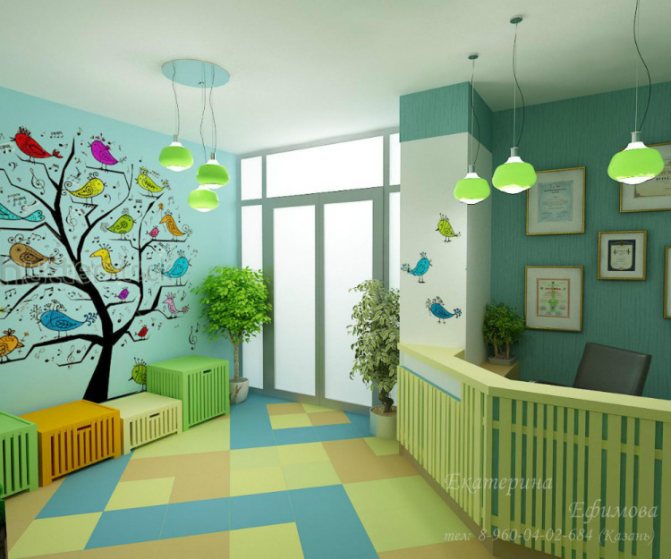
Kids love to decorate the kindergarten area
Aesthetic education in a kindergarten
Aesthetic education is designed to teach a preschooler:
- see beauty around;
- understand and appreciate art;
- reach for beauty.
The first place in aesthetic education in preschool educational institutions is occupied by the design of the territory of the kindergarten and its premises. This is the first thing a child sees when coming to kindergarten.
The area should be well-groomed, flowers should be planted in the summer, borders should be whitewashed, and garbage should be removed. The room where the group is located should not be cluttered, colorful or dark and gloomy.
It is important to maintain harmony in color; aesthetics is needed in the details. A library with beautiful illustrated books is needed in every group. Hanging reproductions of paintings or illustrations will be of great benefit.
Observations during a walk in the second junior group
Contemplation of nature is no less important. The teacher should teach this to the preschooler during walks. Example: pay attention to:
- insects (beautiful butterflies, hardworking ants, nimble dragonflies);
- dew on the grass;
- the first yellowed leaves;
- red bunches of rowan;
- early arrival of winter.
Note ! All this trains children's minds, develops their taste, and makes them more attentive.
We conduct a master class on artistic and aesthetic development
The master class “Swan Fidelity” (finger painting) will be useful.
Type: practical lesson.
Equipment: thick A3 paper, pencil, eraser, gouache, brushes, water jar, table.
Objective: to introduce preschoolers to a new drawing technique, to develop imagination and creativity.
Duration: one academic hour.
Progress:
- “Guys, you probably know about the existence of such birds as swans. They are very beautiful and graceful. They have a flexible, long neck. They come in white and black. They differ in that they create a pair for life. And if one swan dies, then the second may die of melancholy.”
- “Today we will draw a couple of these swans. But we will paint the birds themselves not with a brush, but with our palms! This is such a visual device.”
- “Take a piece of paper and lay it horizontally.”
- “Using a simple pencil, outline the background on which you will have the swans (an island in the water, water, grass, sandy shore).”
- “Next, use a large brush and paints to fill the background with color.”
- “You will need to depict swans like this: take black or white gouache.”
- “Apply a thick layer of paint to each palm separately and stamp the palms so that the swan heads (thumbs) are reaching towards each other.”
- “Press your index, middle, ring and little fingers together. Look what a cool drawing it turns out."
- “Small ones can be improved with a thin brush or fingers. Look how unusual the swans turned out!
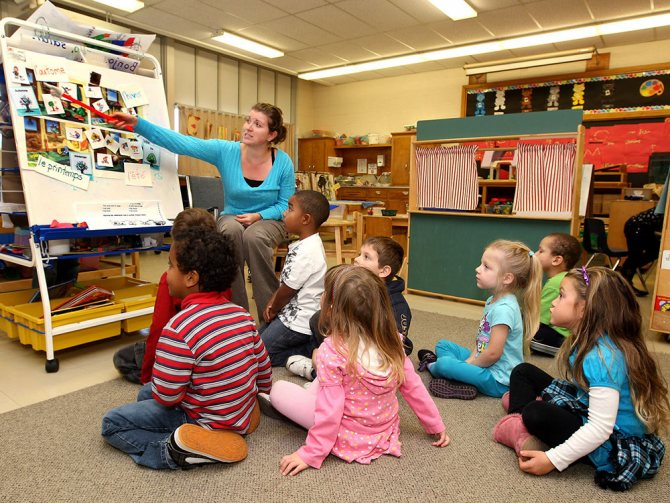
Collective development is a priority
Methods
Methods of aesthetic education of preschool children include:
- personal example of parents and educators.
- conversations;
- classes held in kindergarten and then at school;
- additional classes in clubs and sections of interest;
- visiting exhibitions and museums.
The most effective method is considered to be the first, personal example, which includes both appearance and behavioral characteristics, and moral attitudes. Looking at parents and educators who understand beauty and enjoy contemplating it, the child himself will want to become the same. Only in this way can an ideal be formed, which will later form the basis of the child’s artistic consciousness.
Based on the method of transmitting information, methods can be divided into 2 groups:
- Visual. Showing a child a work of art or folk craft.
- Verbal. A story about a particular artist, a painting, an explanation of what exactly the author wanted to express in his work.
Both groups are important. The first allows you to get an idea, the second allows you to understand your own feelings. In any case, it is necessary to focus on age characteristics and select material that is understandable to the baby.
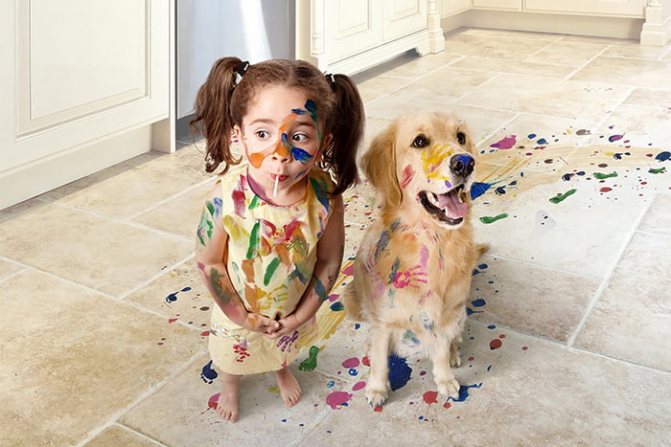
Principles
Let's consider the basic principles of aesthetic education of preschoolers:
- It should be carried out in close connection with educational and educational work.
- Various forms and methods of artistic activity should be used.
- Each child needs to be approached individually; all children are different. What one person likes may cause boredom to another.
- The work must be carried out purposefully. At the same time, you should not allocate any special time for the aesthetic development of the baby; it should be carried out constantly.
It is necessary to focus on common values, to cultivate in the child love and respect for national culture and traditions.
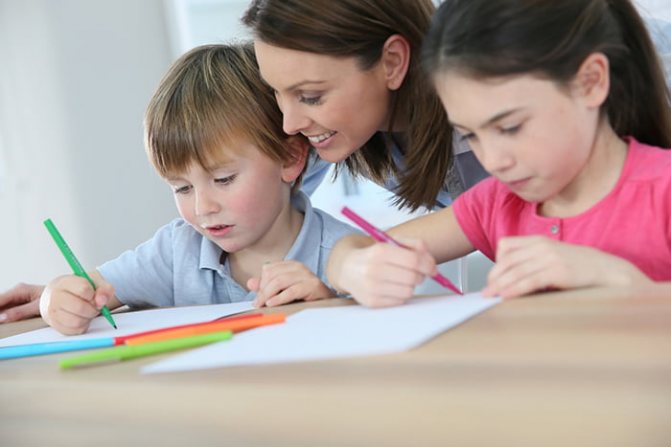
Features of the development of technical creativity in preschool children
Technical creativity teaches a preschool child not only perseverance and patience, but also helps to develop certain abilities:
- The ability to find non-standard solutions to the tasks assigned to them and select a means for these solutions.
- Plan your activities.
- Compare, find differences and similarities, generalize.
- Select parts and combine them into a whole.
- Analyze your actions step by step, draw conclusions, give an account of your actions, assume further options for the development of events, correct shortcomings, identify advantages and use them in the future.
Calendar plan in the preparatory group for each day according to the Federal State Educational Standard
In addition, preschoolers learn to interact with each other, gain experience working in a team, learn to negotiate, look for a way out of the current situation, and develop their imagination.
Note ! The main type of activity of a preschooler according to the Federal State Educational Standard is play, which is inextricably linked with a toy. One follows from the other: a toy gives rise to play activity, and by developing play activity, it attracts new toys. Therefore, it is better to engage in technical creativity with little ones through play. The game helps to captivate the preschooler, interest him and achieve the desired result.
The best option for technical creativity of kids are:
- magnetic constructors;
- building kits;
- various cubes;
- block constructors;
- modeling kits;
- constructors with joint fastening;
- bolt-on constructors.
Innovative technologies in preschool educational institutions to unlock the creative potential of preschoolers
Innovative technologies in kindergarten are the use of modern components to improve the educational process.
The main types of innovative technologies in preschool educational institutions include:
- Project activities. The project is developed together with the teacher, helps the preschooler acquire new knowledge and systematize existing knowledge. The projects themselves are classified according to several criteria.
- Personality-oriented technologies. The teacher’s task is to select methods, games and activities that allow a particular child to develop as much as possible.
- Information and communication technologies. Consists of using personal computers, projectors, tablets, interactive whiteboards and other things in the classroom. The technology helps to attract kids. They are developing new skills. With it you can watch educational videos, films, cartoons. Improves educational process and presentation.
- Health-saving technologies. They consist of conducting thematic conversations, morning exercises, physical education sessions, sports festivals and other sporting events.
- Research activities. A research paper is similar to a course project. Teaches a preschooler to explore the world around him, understand the task at hand, find the problem and give it a definition. The main activity in this case is an experiment that contributes to the development of the baby’s thinking.
- Corrective technologies. Aimed at relieving emotional tension in the group. Relaxing music, color therapy, special games and exercises can be used.
- Gaming technologies. They occupy a dominant role due to the fact that play is the main activity of preschool children. At the same time, the game has a cognitive and developmental function.
The artistic and aesthetic development of a preschooler helps to make the child a comprehensively developed personality, capable of appreciating and seeing the beauty around him, and creating beauty with his own hands.
Specifics of upbringing in the family
We have already noted that you should not rely solely on preschool educational institutions, entrusting educators with the aesthetic development of the baby. It is also important for parents to put some effort into this. Let's pay attention to the following points:
- Parents should always look neat and tidy and behave respectfully towards each other, since the child takes a lot from them.
- It is important to read good literature, fairy tales and poems to your child, and be sure to talk about the content of what you read. This form of work also helps to enrich the baby’s vocabulary.
- Together with your child you can draw, make applique or crafts. To prevent your baby from getting bored, you can use various artistic techniques, drawing with gouache, watercolors, crayons, and felt-tip pens.
- The aesthetics of everyday life are also important. If the apartment is dirty and not cleaned, there can be no question of any desire for perfection. Therefore, you need to decorate the children's room with taste and love.
- The formation of musical taste begins with listening to nursery rhymes, lullabies, and children's songs.
Of particular importance are conversations that will help the child get answers to the questions he has, learn to distinguish the beautiful from the disgusting, the sublime and harmonious from the base and chaotic.
Let us outline the most important conditions for the development of children's creativity:
- Relaxed atmosphere. You should not put pressure on your child and force him to draw or sculpt, this will only destroy his desire to create his own works.
- Active use of game forms of work.
- Praise should be given constantly; it is important for the child to understand that his mother is pleased with him and is proud of his efforts. But you shouldn’t scold; in some cases you can scold a little.
Only in this case will it be possible to achieve positive results - the desire for one’s own creative pursuits and respect for the works of others.
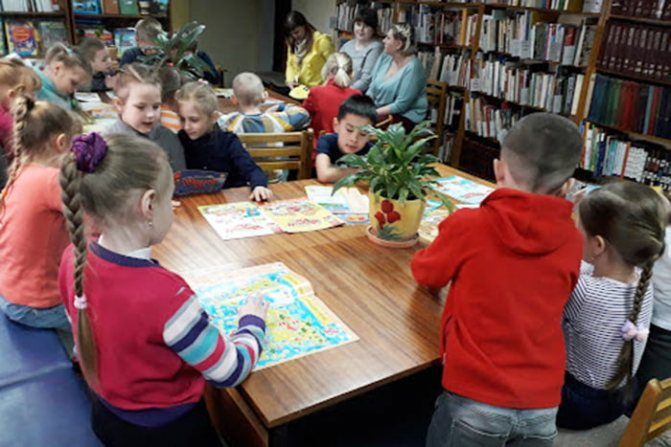
Events in libraries
Nowadays, libraries are undeservedly forgotten and are not particularly popular. Meanwhile, it is here that quite interesting events are often held, aimed at shaping and developing children’s artistic taste. Their additional advantage is that visiting is free. Please note that such events will be of interest to older children - older preschoolers and younger schoolchildren.
Attending library evenings, meetings and presentations will teach your child to love books and respect the written word; visiting thematic exhibitions will allow you to determine your own interests. And the literary and poetry evenings held will introduce the work of poets and writers.
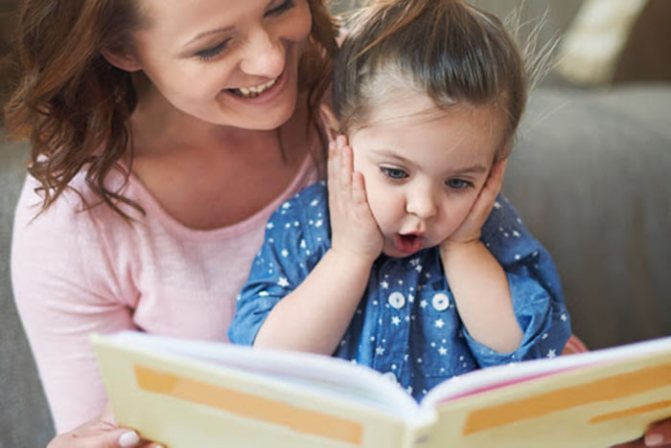
Tips and tricks for parents
It is important to carry out aesthetic education of the child by all available means, creating a harmonious environment for him, giving him the opportunity to independently engage in artistic creativity in the chosen direction. Parents need to talk with the baby and give answers to all the questions he has. And classes with a teacher will help develop taste.
When choosing forms of work, you should focus on the age of the baby:
- Visiting the theater is permissible from 1.5 years of age; the repertoire of puppet theaters includes short-lasting productions that will not have time to tire the baby.
- You can talk about paintings, musical works, and talk about their authors from the age of 3–4; children already understand a lot and will definitely listen with interest and ask questions.
- At 4–5 years old you can visit an exhibition, including a library one.
- At 5-6 years old - go to the Philharmonic or ballet.
Giving a child the opportunity to create is another method of aesthetic education, and he can choose the type of activity to his liking. Some people like to draw pictures in the sand, while others like to write short congratulatory poems for mom or dad. Parents should not limit creative impulses, but give their child the freedom to choose and realize their own ideas.
Do not underestimate the importance of aesthetic education for preschoolers; it will help to spiritually enrich the child’s personality, make him developed, rich, able to feel subtly and receive aesthetic pleasure.
Activities to develop abilities in preschool age
There is a huge variety of creative activities that contribute to the development of artistic perception of preschoolers, who vary in age and type of creativity.
Classes for 3-4 years
REFERENCE! At this age, babies are just learning to express a positive reaction when they see familiar objects. They are not yet ready to perceive an artistic image, but choose certain pictures simply because they like them or resemble familiar objects.
One of the effective ways to develop artistic and aesthetic skills in children of primary preschool age is unconventional drawing. This provides an incentive to develop the ability to think outside the box and experiment. The arsenal of unconventional drawing is very diverse:
- Drawing with stencils - in this case, paint is applied to a pre-prepared stencil using a variety of tools: a sponge, a brush, a roller or even ordinary rags.
- Drawing with stamps, palms, leaves, cotton swabs, etc. - in this case, paint is applied to a stamp or something that replaces it and an impression is made on paper. Prints can be formed into patterns, and you can experiment with color.
- Drawing on wet paper differs from regular drawing in that paint is applied to a pre-moistened sheet and it spreads, creating unexpected patterns. At the same time, the child learns to follow what happens and guide the drawing process.
Modeling from plasticine not only forms artistic and aesthetic perception, but also promotes the development of fine motor skills, which is very important in preschool age. To deepen the effect of these activities, plasticine figures sculpted by children are used to dramatize fairy tales.
IMPORTANT! Musical classes can be either an independent form of creativity or accompany the creative process in other directions. For example, when a teacher turns on music while drawing or sings songs with children while dramatizing fairy tales.
Classes for 5-7 years old
REFERENCE: At the age of 5, a child is already able to receive aesthetic pleasure from contemplating a painting, but for him the color scheme is more important than the composition. At the age of 6-7 years, perception becomes much more subtle, children capture the inner mood of the image.

At this age, the possibilities for creative activities with children expand, as the children’s abilities also expand.
Older preschoolers have more complex skills and can complete more complex tasks.
For example, children 6-7 years old can engage in floristry, quilling, papermaking, etc.
Floristry is the creation of compositions from plant materials. It requires the child to be able to see the image, select the necessary shapes and shades of colors, and carefully work with fragile material.
For work, you can use leaves, flowers, twigs, moss and other plant materials.
Quilling is the making of pictures from rolled strips of paper. This is a rather painstaking task that requires patience and perseverance. Artistically, children learn to compose a composition and select colors.
Papermaking is an excellent tool for developing imaginative thinking. By making three-dimensional models from paper, preschoolers solve design problems, show imagination and aesthetic taste. Additionally, paper craft activities can be complemented by storytelling, drama, and other forms of creative development.
IMPORTANT! In older preschool age, children begin to get acquainted with the masterpieces of world artistic culture - paintings, architecture, literature (fairy tales, poems), etc. This happens in the form of conversations, viewing photographs, and reading.
